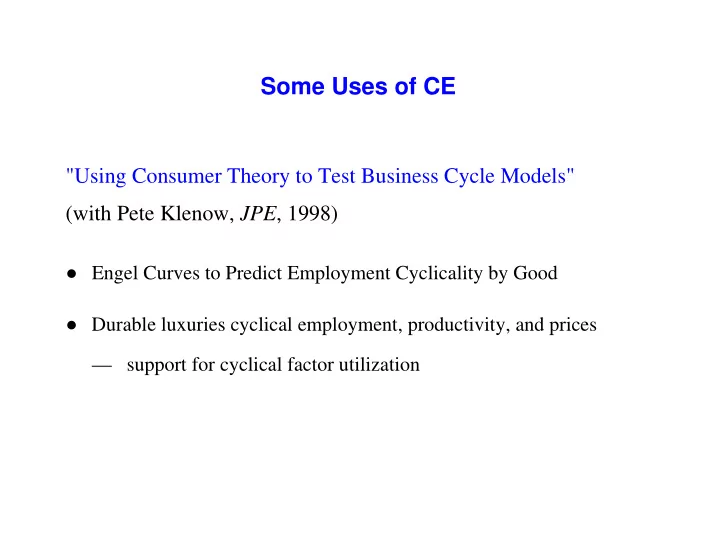

Some Uses of CE "Using Consumer Theory to Test Business Cycle Models" (with Pete Klenow, JPE , 1998) ● Engel Curves to Predict Employment Cyclicality by Good ● Durable luxuries cyclical employment, productivity, and prices — support for cyclical factor utilization
"Quantifying Quality Growth" (with Pete Klenow, AER , 2001) ● Estimate Quality Engel Curves for Durables ● Use Quality Engel Curves as instrument for Quality ● Predicts Unit-Price inflation 1980-1996 across goods ● Also Predicts CPI inflation across goods
Figure 3 Quality Engel Curve for CARS 1.0 real price of car purchased (in logs) 0.5 0.0 OLS -0.5 Kernel -1.0 -1.0 -0.5 0.0 0.5 1.0 household real nondurable consumption (in logs)
Figure 4 Quality Engel Curve for VACUUMS 0.3 real price of vacuum purchased (in logs) 0.2 OLS 0.1 0.0 -0.1 Kernel -0.2 -1.0 -0.5 0.0 0.5 1.0 household real nondurable consumption (in logs)
Figure 5 5 1980-1996 Unit Price Inflation 0 -5 corr = .51 -10 0.0 0.2 0.4 0.6 0.8 1.0 1.2 Quality Slope
"Has Consumption Inequality Mirrored Income Inequality?" (with Mark Aguiar, 2010) ● Large increase in income inequality over last 30 years ● Consumption inequality, measured by CE, rose much less — e.g., Slesnick (2001), Krueger and Perri (2006) ● Use budget constraint and CE data on savings to check consistency ● Use Engel curves across goods for alternative measure — Corrects for systematic errors by good or income
Implied Consumption Inequality 0.40 After Tax Income 0.35 0.30 Log Change from 1980-82 0.25 0.20 0.15 0.10 0.05 0.00 1980 1983 1986 1989 1992 1996 1999 2002 2005
Implied Consumption Inequality 0.40 After Tax Income 0.35 0.30 Log Change from 1980-82 0.25 0.20 Reported Expenditure 0.15 0.10 0.05 0.00 1980 1983 1986 1989 1992 1996 1999 2002 2005
Implied Consumption Inequality 0.40 After Tax Income 0.35 0.30 Y-S Log Change from 1980-82 0.25 0.20 Reported Expenditure 0.15 0.10 0.05 0.00 1980 1983 1986 1989 1992 1996 1999 2002 2005
Two Good Example: Food and Entertainment 9 8 Nondurable Entertainment 7 6 ng Spendi 5 ve 4 i at Rel Total 3 Expenditure 2 Food at Home 1 0 1980 1983 1986 1989 1992 1996 1999 2002 2005 YEAR
Implied Consumption Inequality 0.40 After Tax Income 0.35 0.30 Y-S Log Change from 1980-82 0.25 0.20 Reported Expenditure 0.15 0.10 0.05 0.00 1980 1983 1986 1989 1992 1996 1999 2002 2005
Implied Consumption Inequality 0.40 After Tax Income 0.35 Estimated Expenditure 0.30 Y-S Log Change from 1980-82 0.25 0.20 Reported Expenditure 0.15 0.10 0.05 0.00 1980 1983 1986 1989 1992 1996 1999 2002 2005
Description of Data Used ● Panel feature of data — to match expenditures to income — to instrument across surveys to address measurement error ● All available years (including 1972-73) to uncover long-term trends ● Interview files: Family, ITAB, and MTAB files (MTABS for finer disaggregation, for unit prices for durables)
Suggestions for CE Survey and Products For many questions aggregate household consumption is key ● Exploit household budget constraint as check ● Begin with estimate aggregate expenditures — bring records of check, credit spending, estimate currency flow ● Then drop number of questions that generate little expenditure share
For many questions need CE’s short panel — match income/spending, estimate life cycle or allow fixed effects ● Reductions in attrition would be great ● Bring in households only for full cycle ● Make existing years easier to use as panel — e.g., consistent set of ID’s across census changes — perhaps produce panel version
Recommend
More recommend